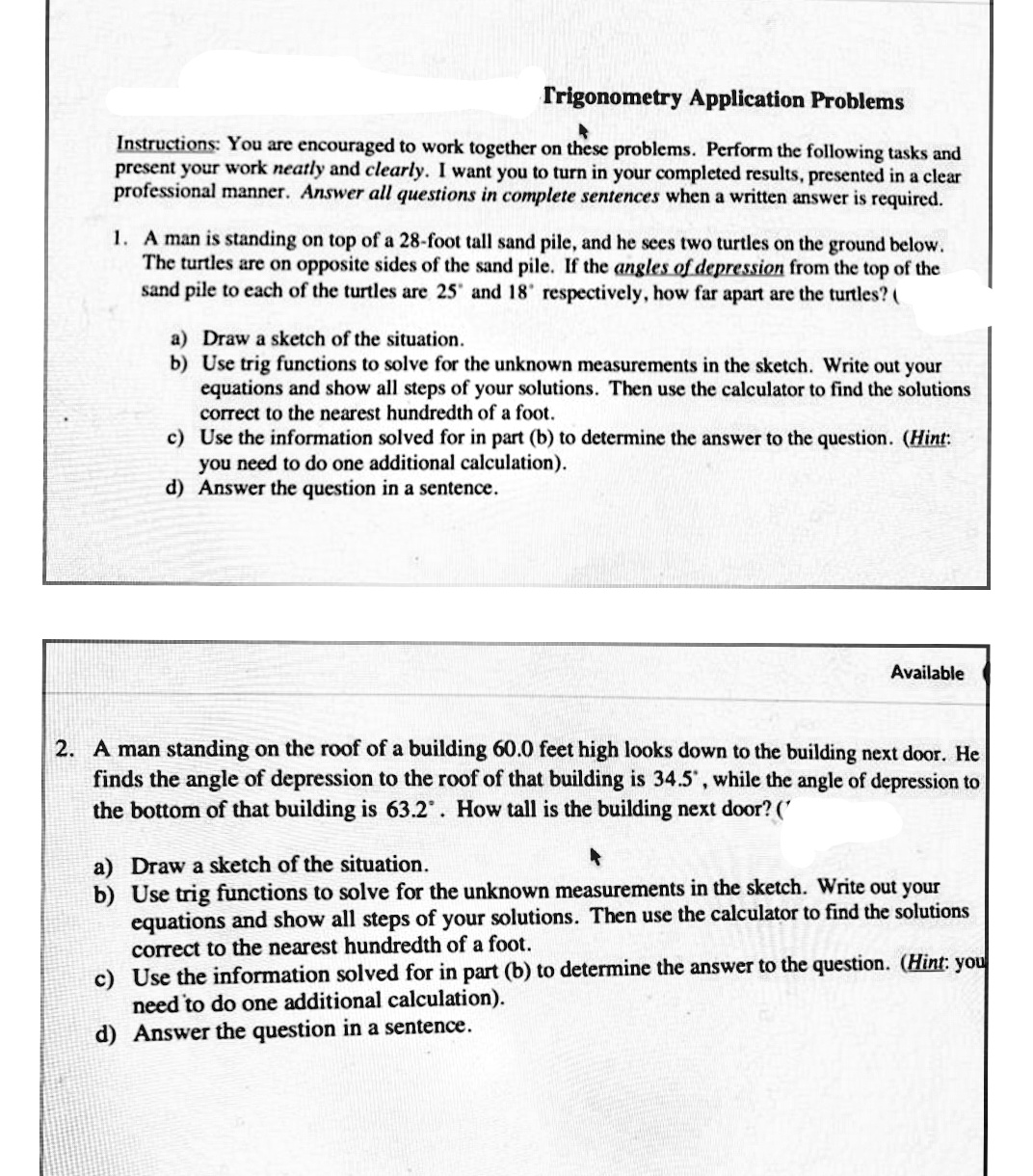1. A man is standing on top of a 28-foot tall sand pile, and he sees two turtles on the ground below. The turtles are on opposite sides of the sand pile. If the angles of depression from the top of the sand pile to each of the turtles are 25' and 18' respectively, how far apart are the turtles? ( a) Draw a sketch of the situation. b) Use trig functions to solve for the unknown measurements in the sketch. Write out your equations and show all steps of your solutions. Then use the calculator to find the solutions correct to the nearest hundredth of a foot. c) Use the information solved for in part (b) to determine the answer to the question. (Hint: you need to do one additional calculation). d) Answer the question in a sentence.
1. A man is standing on top of a 28-foot tall sand pile, and he sees two turtles on the ground below. The turtles are on opposite sides of the sand pile. If the angles of depression from the top of the sand pile to each of the turtles are 25' and 18' respectively, how far apart are the turtles? ( a) Draw a sketch of the situation. b) Use trig functions to solve for the unknown measurements in the sketch. Write out your equations and show all steps of your solutions. Then use the calculator to find the solutions correct to the nearest hundredth of a foot. c) Use the information solved for in part (b) to determine the answer to the question. (Hint: you need to do one additional calculation). d) Answer the question in a sentence.
Holt Mcdougal Larson Pre-algebra: Student Edition 2012
1st Edition
ISBN:9780547587776
Author:HOLT MCDOUGAL
Publisher:HOLT MCDOUGAL
Chapter9: Real Numbers And Right Triangles
Section9.4: Real Numbers
Problem 42E
Related questions
Concept explainers
Ratios
A ratio is a comparison between two numbers of the same kind. It represents how many times one number contains another. It also represents how small or large one number is compared to the other.
Trigonometric Ratios
Trigonometric ratios give values of trigonometric functions. It always deals with triangles that have one angle measuring 90 degrees. These triangles are right-angled. We take the ratio of sides of these triangles.
Question

Transcribed Image Text:Trigonometry Application Problems
Instructions: You are encouraged to work together on these problems. Perform the following tasks and
present your work neatly and clearly. I want you to turn in your completed results, presented in a clear
professional manner. Answer all questions in complete sentences when a written answer is required.
1. A man is standing on top of a 28-foot tall sand pile, and he sees two turtles on the ground below.
The turtles are on opposite sides of the sand pile. If the angles of depression from the top of the
sand pile to each of the turtles are 25 and 18' respectively, how far apart are the turtles? (
a) Draw a sketch of the situation.
b) Use trig functions to solve for the unknown measurements in the sketch. Write out your
equations and show all steps of your solutions. Then use the calculator to find the solutions
correct to the nearest hundredth of a foot.
c) Use the information solved for in part (b) to determine the answer to the question. (Hint:
you need to do one additional calculation).
d) Answer the question in a sentence.
Available
2. A man standing on the roof of a building 60.0 feet high looks down to the building next door. He
finds the angle of depression to the roof of that building is 34.5', while the angle of depression to
the bottom of that building is 63.2. How tall is the building next door? ('
a) Draw a sketch of the situation.
b) Use trig functions to solve for the unknown measurements in the sketch. Write out your
equations and show all steps of your solutions. Then use the calculator to find the solutions
correct to the nearest hundredth of a foot.
c) Use the information solved for in part (b) to determine the answer to the question. (Hint: you
need to do one additional calculation).
d) Answer the question in a sentence.
Expert Solution
This question has been solved!
Explore an expertly crafted, step-by-step solution for a thorough understanding of key concepts.
This is a popular solution!
Trending now
This is a popular solution!
Step by step
Solved in 2 steps with 2 images

Knowledge Booster
Learn more about
Need a deep-dive on the concept behind this application? Look no further. Learn more about this topic, trigonometry and related others by exploring similar questions and additional content below.Recommended textbooks for you

Holt Mcdougal Larson Pre-algebra: Student Edition…
Algebra
ISBN:
9780547587776
Author:
HOLT MCDOUGAL
Publisher:
HOLT MCDOUGAL

Mathematics For Machine Technology
Advanced Math
ISBN:
9781337798310
Author:
Peterson, John.
Publisher:
Cengage Learning,

Trigonometry (MindTap Course List)
Trigonometry
ISBN:
9781305652224
Author:
Charles P. McKeague, Mark D. Turner
Publisher:
Cengage Learning

Holt Mcdougal Larson Pre-algebra: Student Edition…
Algebra
ISBN:
9780547587776
Author:
HOLT MCDOUGAL
Publisher:
HOLT MCDOUGAL

Mathematics For Machine Technology
Advanced Math
ISBN:
9781337798310
Author:
Peterson, John.
Publisher:
Cengage Learning,

Trigonometry (MindTap Course List)
Trigonometry
ISBN:
9781305652224
Author:
Charles P. McKeague, Mark D. Turner
Publisher:
Cengage Learning

Elementary Geometry For College Students, 7e
Geometry
ISBN:
9781337614085
Author:
Alexander, Daniel C.; Koeberlein, Geralyn M.
Publisher:
Cengage,

Algebra: Structure And Method, Book 1
Algebra
ISBN:
9780395977224
Author:
Richard G. Brown, Mary P. Dolciani, Robert H. Sorgenfrey, William L. Cole
Publisher:
McDougal Littell

Algebra and Trigonometry (MindTap Course List)
Algebra
ISBN:
9781305071742
Author:
James Stewart, Lothar Redlin, Saleem Watson
Publisher:
Cengage Learning